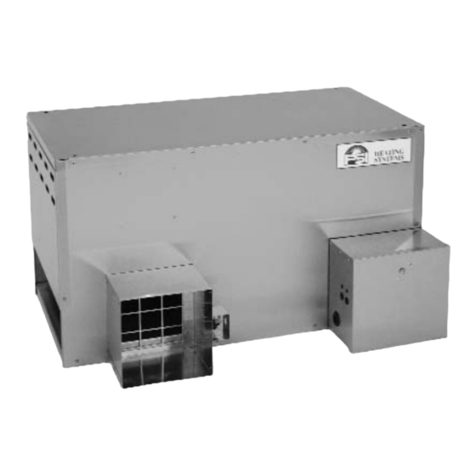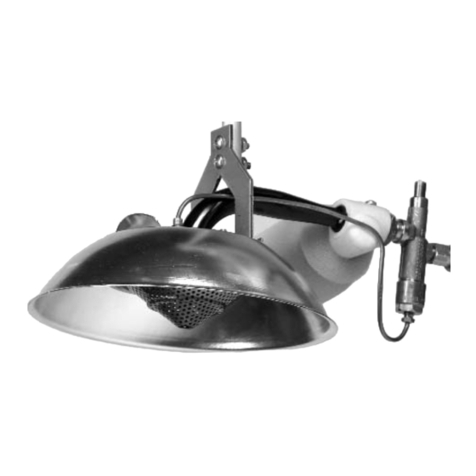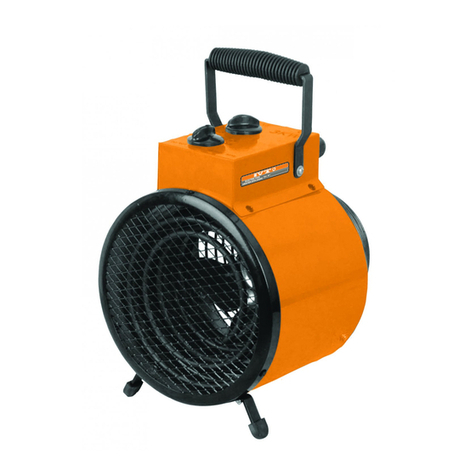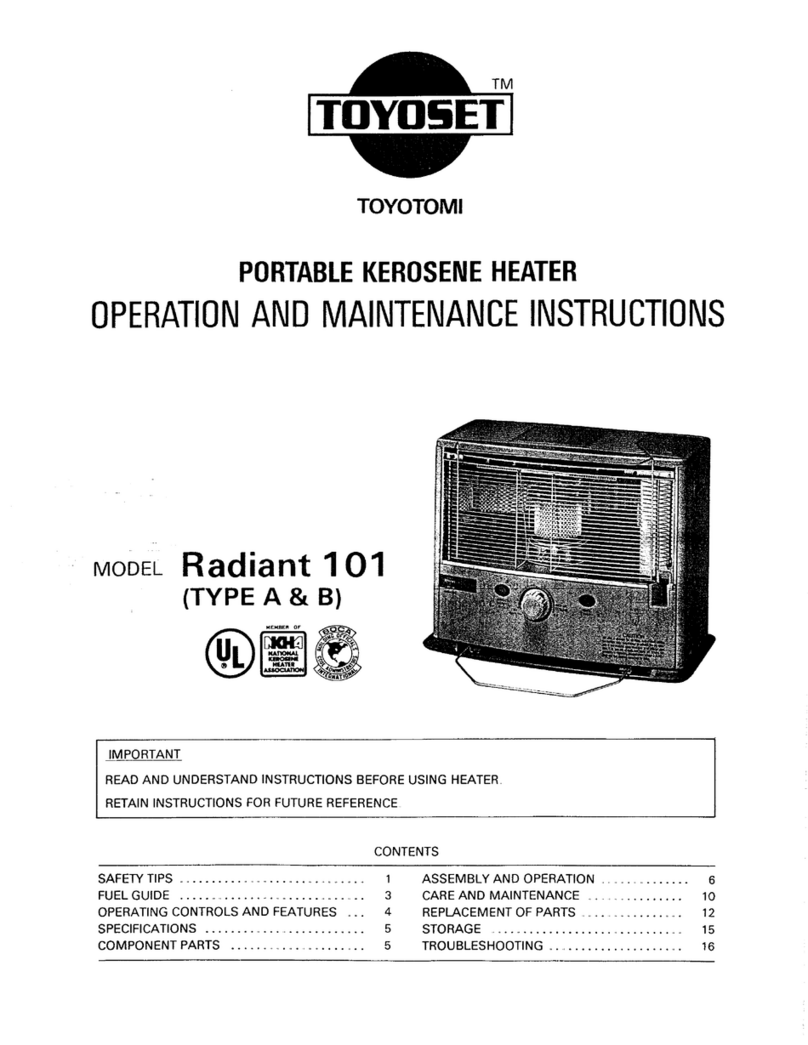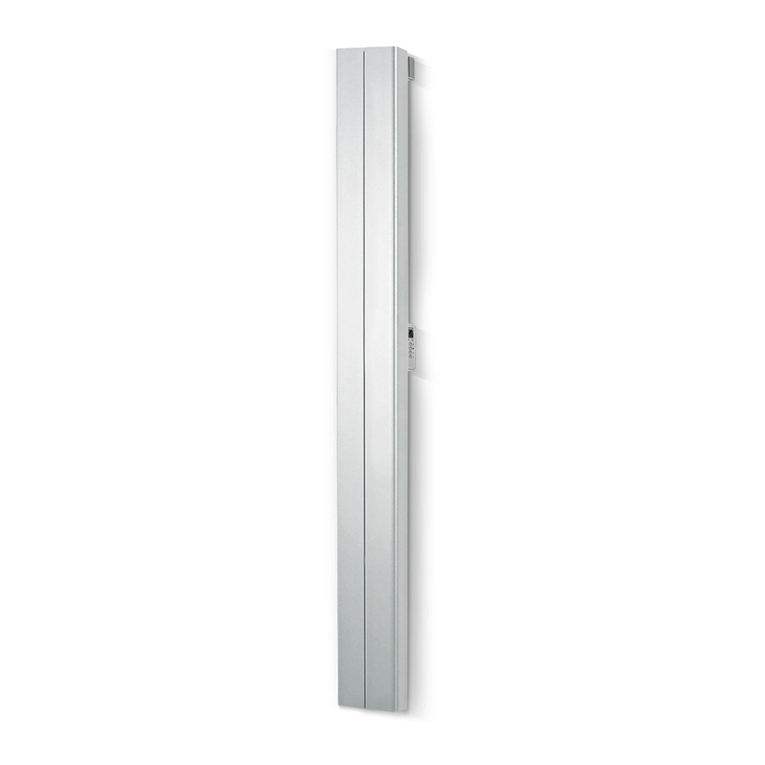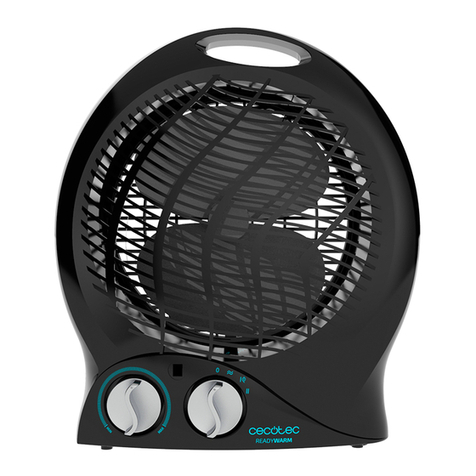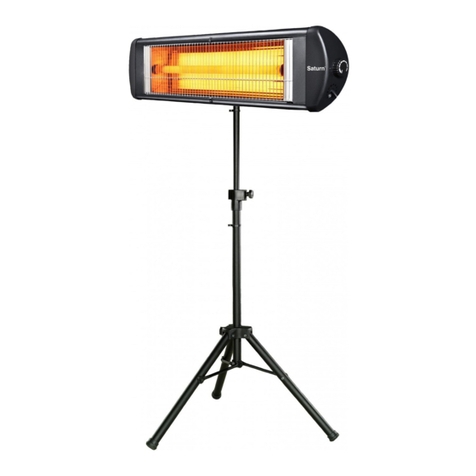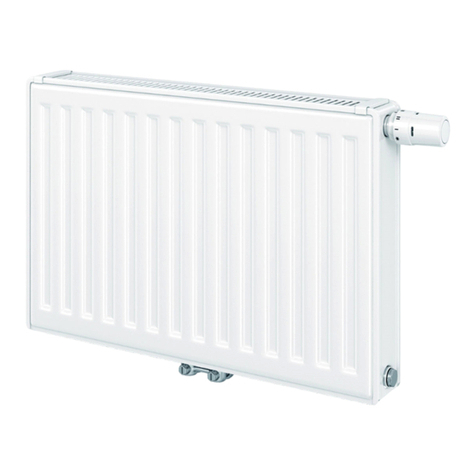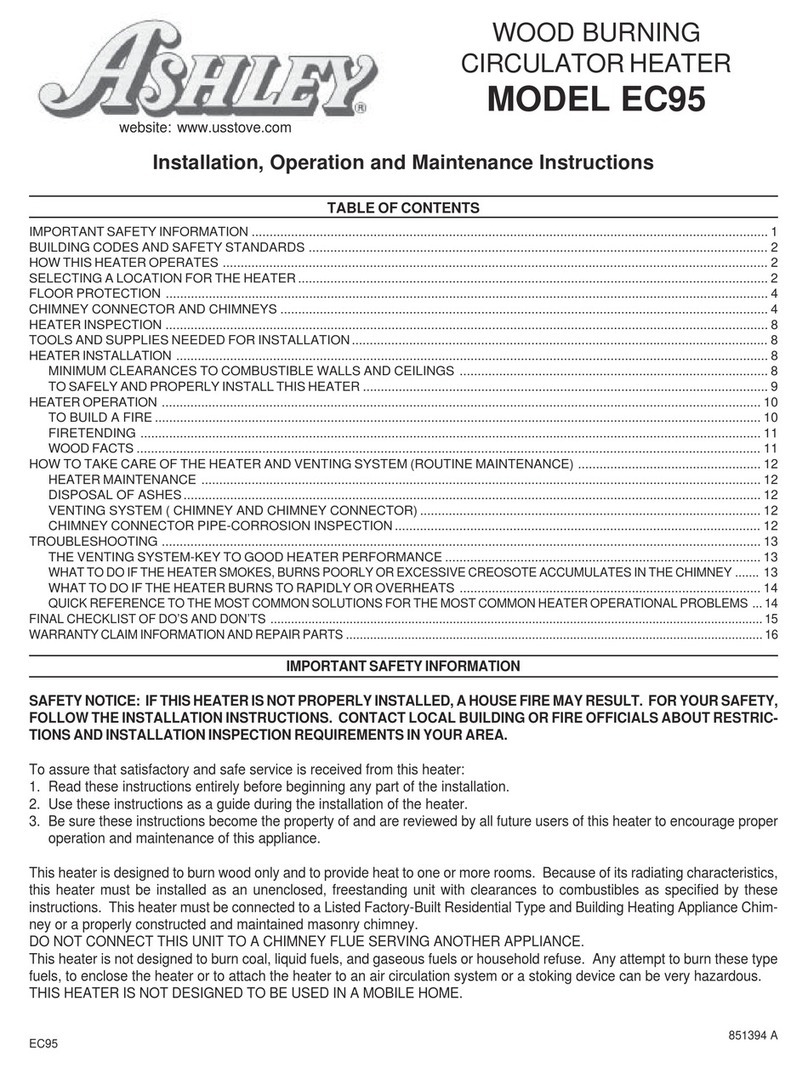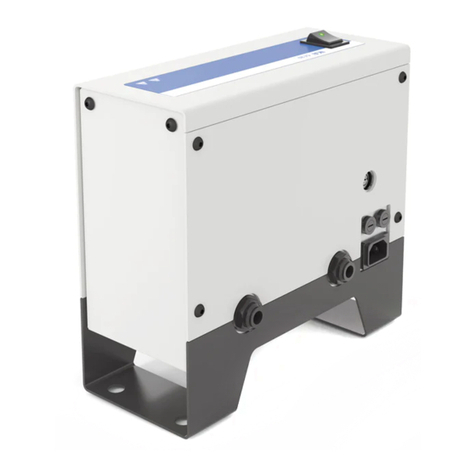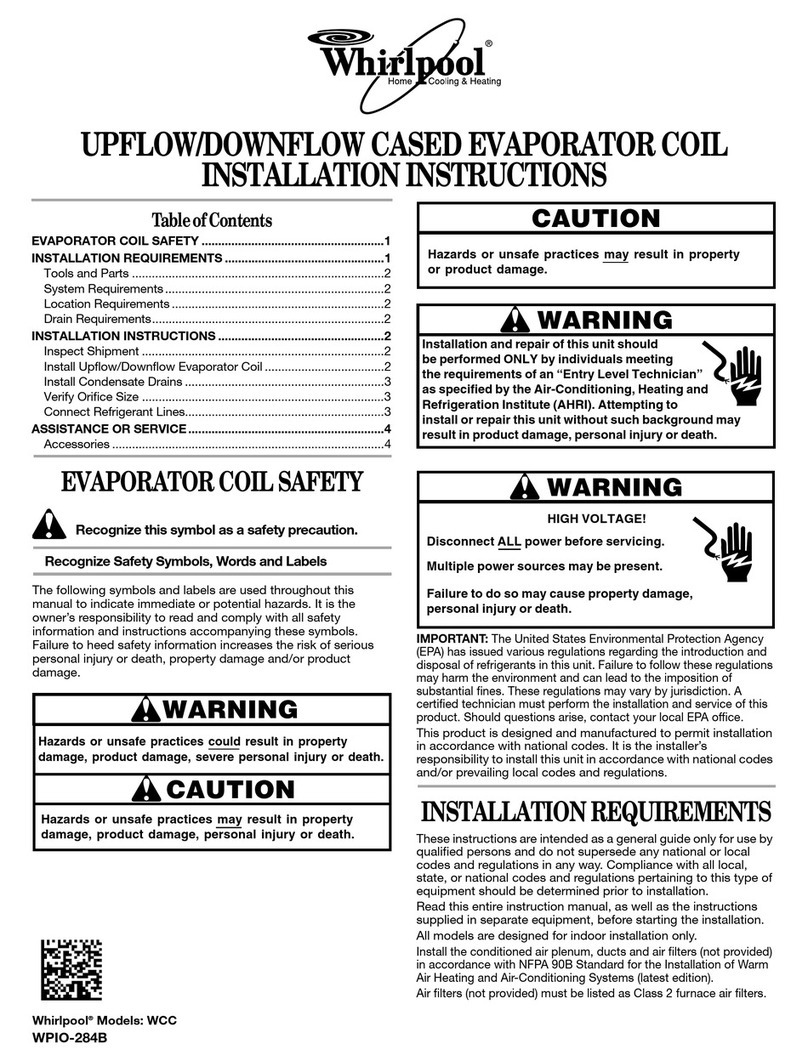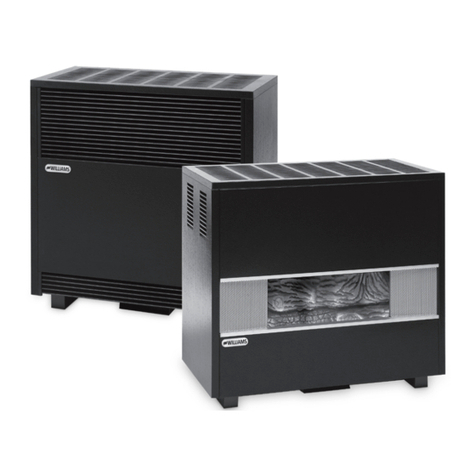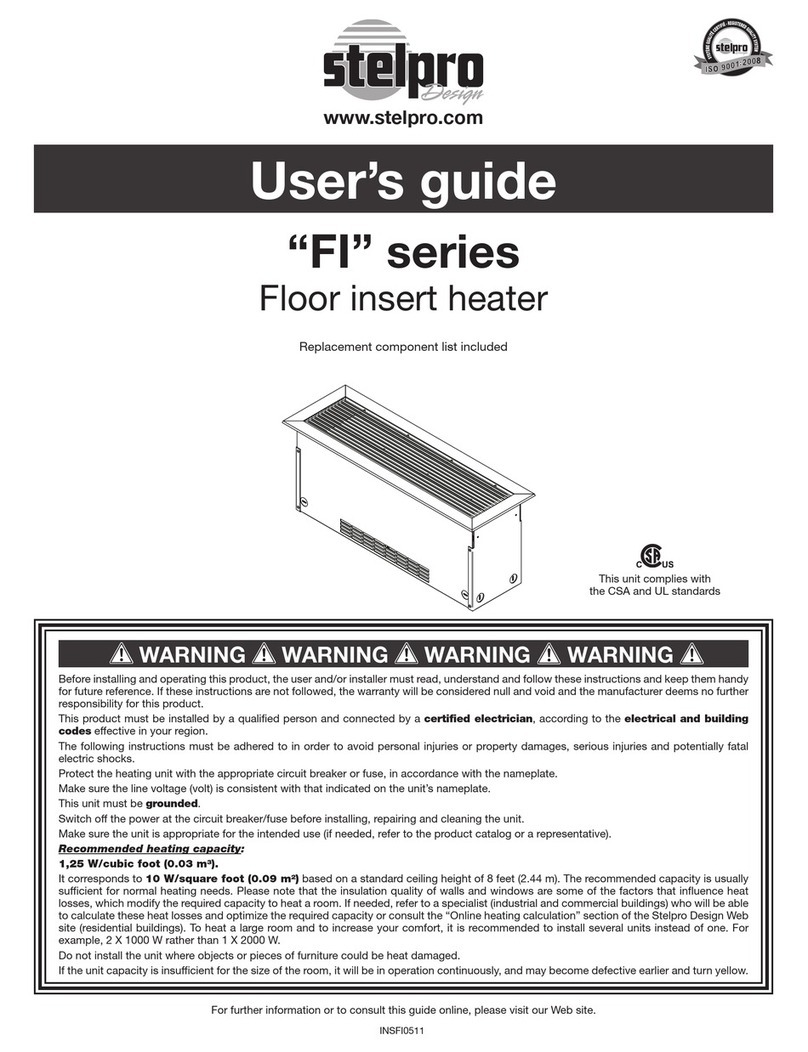PSI 1450 Series Manual

Congratulations!
You have purchased the finest agricultural building heater available.
Your new PSI heater incorporates the benefits from the most experienced
manufacturer of heating products using state-of-the-art technology.
We, at PSI, thank you for your confidence in our products and
welcome any suggestions or comments you may have......call us, at
800-562-2966.
Owner's Manual and Instructions
Agricultural Animal Confinement Building Heaters
F150-81481-A
IGNITION OUTPUT
SERIES TYPE (Btuh) FUEL
Available in either
Propane Vapor
Withdrawal or
Natural Gas
Configurations.
W6636 East Avenue North, Onalaska, WI USA ■800-562-2966 ■Fax: 608-783-6115
1450 Spark
1450 Ignition
60,000
150,000
225,000

ATTENTION ALL USERS
Agricultural Confinement Building Heaters
Agricultural confinement building heaters are intended only
for installation in farm buildings used for the confinement of
poultry and livestock and which are not used as human
workplaces for periods in excess of 4 hours per day. This
type of heater is not intended for use in other types of
buildings including those used for human dwelling, grain
storage or grain handling or where gasoline or other liquids
having flammable vapors are stored or used.
This heater has been tested and evaluated by ITS/Warnock
Hersey in accordance with:
■ANSI\IAS U.S. LC 2-1996, ANSI\IAS LC 2A-1998 Direct
Gas Fired Circulating Heaters for Agricultural Animal
Confinement Buildings.
■WP-GPN-003 and is listed and approved for Canadian
installations as an agricultural confinement building
heater.
■CAN 1-2.20 and is listed and approved for Canadian
installations as a gas-fired brooder
■CAN 1-2.21 Gas Fired Appliances for Outdoor
Installation
■CAN/CGA 2.17 Gas Fired Appliances for Use at High
Altitudes
■NEC 547 National Electric Code - Agricultural Buildings
Agricultural Building Heaters
Agricultural building heaters are intended only for
installation in farm buildings excluding those used for
human dwelling, grain storage or grain handling, or where
gasoline or other liquids having flammable vapors are stored
or used.
This heater has been tested and evaluated by ITS/Warnock
Hersey in accordance with GPN-003 and is listed and
approved for Canadian installations as an agricultural
building heater.
Refer to the ventilation requirements for agricultural building
heaters in this manual
If you are considering using this product for any application
other than its intended use, then please contact your fuel
gas supplier or PSI at (800) 562-2966.

WARNING
Fire and Explosion Hazard
■Not for home or recreational vehicle use.
■Installation of this heater in a home or
recreational vehicle may result in a fire or
explosion.
■Fire or explosions can cause property
damage or loss of life.
FOR YOUR SAFETY
If you smell gas:
■Open windows.
■Don't touch electrical switches.
■Extinguish any open flame.
■Immediately call your gas supplier.
FOR YOUR SAFETY
Do not store or use gasoline or other flammable
vapors and liquids in the vicinity of this or any
other appliance.
WARNING
Fire and Explosion Hazard
■Keep solid combustibles a safe distance
away from the heater.
■Solid combustibles include wood or paper
products, feathers, straw, and dust.
■Do not use the heater in spaces which
contain or may contain volatile or airborne
combustibles.
■Volatile or airborne combustibles include
gasoline, solvents, paint thinner, dust
particles or unknown chemicals.
■Failure to follow these instructions may
result in a fire or explosion.
■Fire or explosions can lead to property
damage, personal injury or loss of life.
GENERAL HAZARD WARNING
■Failure to comply with the precautions and instructions provided with this heater, can result in:
— Death
— Serious bodily injury or burns
— Property damage or loss from fire or explosion
— Asphyxiation due to lack of adequate air supply or carbon monoxide poisoning
— Electrical shock
■Read this Owner’s Manual before installing or using this heater.
■Only properly-trained service people should repair or install this heater.
■Save this Owner’s Manual for future use and reference.
■Owner’s Manuals and replacement labels are available at no charge. For assistance, contact
PSI at 800-562-2966.
WARNING
■Proper gas supply pressure must be provided to the inlet of the heater.
■Refer to the heater’s dataplate for proper gas supply pressure.
■Gas pressure in excess of the maximum inlet pressure specified at the heater inlet can cause
fires or explosions.
■Fires or explosions can lead to serious injury, death, building damage or loss of livestock.
■Gas pressure below the minimum inlet pressure specified at the heater inlet may cause
improper combustion.
■Improper combustion can lead to asphyxiation or carbon monoxide poisoning and therefore
serious injury or death to humans and livestock.
2
CONSIGNES DE SECURITE
Si vous sentez une odeur de gaz:
■Ouvrez le fenetres.
■Ne touchez pas aux interrupteurs
electriques.
■Eteignez toute flamme nue.
■Contactez immediatement votre
compangie de gaz.
CONSIGNES DE SECURITE
Ill es interdit d'utiliser des liquides
inflammables ou degageant des vapeurs
inflammables, a proximite de tout appareil
fonctionnant au gaz.

Table of Contents
This Owner's Manual includes all options and accessories
commonly used on this heater. However, depending on the
configuration purchased, some options and accessories
may not be included.
When calling for technical service assistance, or for other
specific information, always have model number and serial
number available. This information is contained on the
dataplate. The dataplate is located on the exterior of the
case assembly on the blower outlet side of the heater.
This manual will instruct you in the operation and care of
your unit. Have your qualified installer review this manual
with you so that you fully understand the heater and how it
functions.
The gas supply line installation, installation of the heater,
and repair and servicing of the heater requires continuing
expert training and knowledge of gas heaters and should
not be attempted by anyone who is not so qualified. See
page 6 for definition of the necessary qualifications.
Contact your local PSI distributor or PSI for assistance, or if
you have any questions about the use of the equipment or
its application.
PSI has a policy of continuous product improvement. It
reserves the right to change specifications and design
without notice.
SECTION PAGE
General Information . . . . . . . . . . . . . . . . . . . . . . . . . . . . . . . . . . . . . . . . . . . . . . . . . . . . . . . . . . . . . . . . . . .3
Heater Specifications . . . . . . . . . . . . . . . . . . . . . . . . . . . . . . . . . . . . . . . . . . . . . . . . . . . . . . . . . . . . . . . . . .4
Safety Precautions . . . . . . . . . . . . . . . . . . . . . . . . . . . . . . . . . . . . . . . . . . . . . . . . . . . . . . . . . . . . . . . . . . . .5
Installation Instructions
General . . . . . . . . . . . . . . . . . . . . . . . . . . . . . . . . . . . . . . . . . . . . . . . . . . . . . . . . . . . . . . . . . . . . . . . . .7
Ventilation . . . . . . . . . . . . . . . . . . . . . . . . . . . . . . . . . . . . . . . . . . . . . . . . . . . . . . . . . . . . . . . . . . . . . . .8
Air Diverter Installation Instructions . . . . . . . . . . . . . . . . . . . . . . . . . . . . . . . . . . . . . . . . . . . . . . . . . .8
Hanging Instructions . . . . . . . . . . . . . . . . . . . . . . . . . . . . . . . . . . . . . . . . . . . . . . . . . . . . . . . . . . . . . . .9
Sediment Trap Assembly . . . . . . . . . . . . . . . . . . . . . . . . . . . . . . . . . . . . . . . . . . . . . . . . . . . . . . . . . .10
Thermostat Installation . . . . . . . . . . . . . . . . . . . . . . . . . . . . . . . . . . . . . . . . . . . . . . . . . . . . . . . . . . .10
Manual Shut-Off Valve, Hose and Regulator Assembly . . . . . . . . . . . . . . . . . . . . . . . . . . . . . . . . . .10
Start-Up Instructions . . . . . . . . . . . . . . . . . . . . . . . . . . . . . . . . . . . . . . . . . . . . . . . . . . . . . . . . . . . . . . . . .11
Shut-Down Instructions . . . . . . . . . . . . . . . . . . . . . . . . . . . . . . . . . . . . . . . . . . . . . . . . . . . . . . . . . . . . . . .11
Variable Heat Output . . . . . . . . . . . . . . . . . . . . . . . . . . . . . . . . . . . . . . . . . . . . . . . . . . . . . . . . . . . . . . . . .12
Cleaning Instructions . . . . . . . . . . . . . . . . . . . . . . . . . . . . . . . . . . . . . . . . . . . . . . . . . . . . . . . . . . . . . . . . .13
Maintenance Instructions . . . . . . . . . . . . . . . . . . . . . . . . . . . . . . . . . . . . . . . . . . . . . . . . . . . . . . . . . . . . .13
Service Instructions
General . . . . . . . . . . . . . . . . . . . . . . . . . . . . . . . . . . . . . . . . . . . . . . . . . . . . . . . . . . . . . . . . . . . . . . . .14
Motor and Fan Wheel Assembly . . . . . . . . . . . . . . . . . . . . . . . . . . . . . . . . . . . . . . . . . . . . . . . . . . . .14
Air Proving Switch with Paddle . . . . . . . . . . . . . . . . . . . . . . . . . . . . . . . . . . . . . . . . . . . . . . . . . . . . . .15
Igniter and Flame Sensor . . . . . . . . . . . . . . . . . . . . . . . . . . . . . . . . . . . . . . . . . . . . . . . . . . . . . . . . . .15
Gas Pressure Checks . . . . . . . . . . . . . . . . . . . . . . . . . . . . . . . . . . . . . . . . . . . . . . . . . . . . . . . . . . . . .16
Testing the Manual Reset High Limit Switch . . . . . . . . . . . . . . . . . . . . . . . . . . . . . . . . . . . . . . . . . . .17
Replacing the Gas Control Valve . . . . . . . . . . . . . . . . . . . . . . . . . . . . . . . . . . . . . . . . . . . . . . . . . . . .17
Troubleshooting Guide . . . . . . . . . . . . . . . . . . . . . . . . . . . . . . . . . . . . . . . . . . . . . . . . . . . . . . . . . . . . . . . .18
Electrical Connection and Ladder Diagram . . . . . . . . . . . . . . . . . . . . . . . . . . . . . . . . . . . . . . . . . . . . . . .23
Mechanical Ventilation Interlock Wiring . . . . . . . . . . . . . . . . . . . . . . . . . . . . . . . . . . . . . . . . . . . . . . . . . .23
Heater Component Function . . . . . . . . . . . . . . . . . . . . . . . . . . . . . . . . . . . . . . . . . . . . . . . . . . . . . . . . . . .24
Parts Identification
Parts Schematic . . . . . . . . . . . . . . . . . . . . . . . . . . . . . . . . . . . . . . . . . . . . . . . . . . . . . . . . . . . . . . . . .25
Parts List . . . . . . . . . . . . . . . . . . . . . . . . . . . . . . . . . . . . . . . . . . . . . . . . . . . . . . . . . . . . . . . . . . . . . . .26
Warranty Policy . . . . . . . . . . . . . . . . . . . . . . . . . . . . . . . . . . . . . . . . . . . . . . . . . . . . . . . . . . . . . . . . . . . . . .27
Replacement Parts and Service . . . . . . . . . . . . . . . . . . . . . . . . . . . . . . . . . . . . . . . . . . . . . . . . . . . . . . . .27
General Information
3

60 150 225
60,000 150,000 225,000
32,000 90,000
30,000 96,000
250 625 900
2.77 6.94 10.42
60 150 225
1.48 4.16 6.94
30 96 150
1/10 H.P. 1/4 H.P. 1/3 H.P.
1550 RPM 1100 RPM 1100 RPM
2.2 6.0 10.0
1.0 2.2 3.7
29 x 12 ½ x 11 ¼ 38 ½ x 18 ½ x 16 ½ 36 ½ x 20 x 18 ¼
TOP 1 ft. (.3 m)
SIDES 1 ft. (.3 m)
BACK 1 ft. (.3 m)
BLOWER
OUTLET
GAS Propane Supply — 6 ft. (1.83 m)
SUPPLY Natural Gas Supply — N/A
Net Weight (lbs.) 48 95 105
Shipping Weight (lbs). 56 105 120
4
Ventilation Air Required to
Support Combustion (CFM)
Heater Specifications
SPECIFICATIONS
Models
Electrical Supply
(Volts/Hz/Phase)
Amp Draw
Dimensions
L x W x H (inches)
Minimum Safe
Distances From
Nearest
Combustible
Materials
STARTING
CONTINUOUS
OPERATION
Motor Characteristics
Ball Bearing
10 ft. (3 m)
115/60/1
Maximum Input per Hour (BTUH)
Minimum Input per Hour (BTUH)
Fuel
Consumption
Per Hour
MAX.
MIN.
Burner Manifold Pressure
(in.W.C.)
Inlet Gas Supply
Pressure Acceptable
at the Inlet of the
Heater for Purpose of
Input Adjustment (in.W.C.)
MAX.
MIN. Propane - 11.0
Natural Gas - 7.0
13.5
Propane - 10.0
Natural Gas - 4.0
PROPANE
NAT. GAS
PROPANE (lbs.)
NAT. GAS (cu.ft.)
PROPANE (lbs.)
NAT. GAS (cu.ft.)
150,000

LP gas and natural gas have man-made odorants added specifically for detection of fuel gas leaks.
If a gas leak occurs, you should be able to smell the fuel gas.
THAT’S YOUR SIGNAL TO GO INTO IMMEDIATE ACTION!
■Do not take any action that could ignite the fuel gas. Do
not operate any electrical switches. Do not pull any
power supply or extension cords. Do not light matches
or any other source of flame. Do not use your
telephone.
■Get everyone out of the building and away from the area
immediately.
■Close all propane gas tank or cylinder fuel supply
valves, or the main fuel supply valve located at the
meter if you use natural gas.
■Propane gas is heavier than air and may settle in low
areas. When you have reason to suspect a propane
leak, keep out of all low areas.
■Natural gas is lighter than air and can collect around
rafters or ceilings.
■Use your neighbor’s phone and call your fuel gas
supplier and your fire department. Do not re-enter the
building or area.
■Stay out of the building and away from the area until
declared safe by the firefighters and your fuel gas
supplier.
■FINALLY, let the fuel gas service person and the
firefighters check for escaped gas. Have them air out
the building and area before you return. Properly
trained service people must repair the leak, check for
further leakages, and then relight the appliance for you.
WARNING
■Do not use this heater for heating human living
quarters.
■Do not use in unventilated areas.
■The flow of combustion and ventilation air must not be
obstructed.
■Proper ventilation air must be provided to support the
combustion air requirements of the heater being used.
■Refer to the specification section of the heater’s
Owner’s Manual, heater dataplate, or contact the PSI to
determine combustion air ventilation requirements of
the heater.
■Lack of proper ventilation air will lead to improper
combustion.
■Improper combustion can lead to carbon monoxide
poisoning in humans leading to serious injury or death.
Symptoms of carbon monoxide poisoning can include
headaches, dizziness and difficulty in breathing.
■Symptoms of improper combustion affecting livestock
can be disease, lower feed conversion, or death.
Asphyxiation Hazard
■Some people cannot smell well. Some people cannot
smell the odor of the man-made chemical added to
propane (LP) or natural gas. You must determine if
you can smell the odorant in these fuel gases.
■Learn to recognize the odor of propane gas and natural
gas. Local propane gas dealers and your local natural
gas supplier (utility) will be more than happy to give you
a scratch and sniff pamphlet. Use it to become familiar
with the fuel gas odor.
■Smoking can decrease your ability to smell. Being
around an odor for a period of time can affect your
sensitivity to that particular odor. Odors present in
animal confinement buildings can mask fuel gas odor.
■The odorant in propane gas and natural gas is
colorless and the intensity of its odor can fade under
some circumstances.
■If there is an underground leak, the movement of gas
through the soil can filter the odorant.
■Propane gas odor may differ in intensity at different
levels. Since propane gas is heavier than air, there may
be more odor at lower levels.
■Always be sensitive to the slightest gas odor. If you
continue to detect any gas odor, no matter how small,
treat it as a serious leak. Immediately go into action as
discussed previously.
5
Safety Precautions
FUEL GAS ODOR
ODOR FADING -- NO ODOR DETECTED
ATTENTION -- CRITICAL POINTS TO REMEMBER!
■Propane gas and natural gas have a distinctive odor.
Learn to recognize these odors. (Reference Fuel Gas
Odor and Odor Fading sections above.
■
If you have not been properly trained in repair and service
of propane gas and natural gas fueled heaters, then do
not attempt to light heater, perform service or repairs, or
make any adjustments to the heater on propane gas or
natural gas fuel system.
■Even if you are not properly trained in the service and
repair of the heater, ALWAYS be consciously aware of
the odors of propane gas and natural gas.
■A periodic sniff test around the heater or at the heater’s
joints; i.e. hose, connections, etc., is a good safety
practice under any conditions. If you smell even a small
amount of gas, CONTACT YOUR FUEL GAS SUPPLIER
IMMEDIATELY. DO NOT WAIT!

1. Do not attempt to install, repair, or service this heater
or the gas supply line unless you have continuing
expert training and knowledge of gas heaters.
Qualifications for service and installation of this
equipment are as follows:
a.
To be a qualified gas heater service person, you
must have sufficient training and experience to
handle all aspects of gas-fired heater installation,
service and repair. This includes the task of
installation, troubleshooting, replacement of
defective parts and testing of the heater. You
must be able to place the heater into a continuing
safe and normal operating condition. You must
completely familiarize yourself with each model
heater by reading and complying with the safety
instructions, labels, Owner’s Manual, etc., that is
provided with each heater.
b.
To be a qualified gas installation person, you must
have sufficient training and experience to handle
all aspects of installing, repairing and altering gas
lines, including selecting and installing the proper
equipment, and selecting proper pipe and tank
size to be used. This must be done in accordance
with all local, state and national codes as well as
the manufacturer’s requirements.
2. All installations and applications of PSI heaters must
meet all relevant local, state and national codes.
Included are L.P. gas, natural gas, electrical, and
safety codes. Your local fuel gas supplier, a local
licensed electrician, the local fire department or
similar government agencies, or your insurance agent
can help you determine code requirements.
a. For U.S.A. installations and applications:
-- ANSI/NFPA 58, latest edition, Standard for
Storage and Handling of Liquefied Petroleum
Gas and/or
-- ANSI Z223.1/NFPA 54, National Fuel Gas Code
-- ANSI/NFPA 70, National Electrical Code.
b. For Canadian Installations and Applications:
--
CAN1-B149.1 or CAN1-B149.2 Installation Codes
-- CSA C22.1 Part 1 Standard Canadian Electrical
Code. CSA C22.2 No. 3, Electrical Features of
Fuel-Burning Equipment.
3. Do not move, handle, or service heater while in
operation or connected to a power or fuel supply.
4. This heater may be installed in areas subject to
washdown. This heater may only be washed on the
external case assembly—see Cleaning Instructions.
Do not wash the interior of the heater. Use only
compressed air, soft brush or dry cloth to clean the
interior of the heater and it’s components. After
external washdown, do not operate the heater until it
is completely dry. In any event, do not operate this
heater for at least one hour after external washdown.
5. For safety, this heater is equipped with manual reset
high-limit switches and an air flow switch. Never
operate this heater with any safety device that has
been bypassed. Do not operate this heater unless all
of these features are fully functioning.
6. Do not operate the heater with its door open or panel
removed.
7. Do not locate fuel gas containers or fuel supply hoses
within 20 ft. of the heater’s blower outlet.
8. Do not block air intakes or discharge outlets of the
appliance. Doing so may cause improper combustion
or damage to heater components leading to property
damage or animal loss.
9. The hose assembly shall be visually inspected on an
annual basis. If it is evident there is excessive
abrasion or wear, or if the hose is cut, it must be
replaced prior to the heater being put into operation.
The hose assembly shall be protected from animals,
building materials, and contact with hot surfaces
during use. The hose assembly shall be that
specified by the manufacturer. See parts list.
10. Check for gas leaks and proper function upon heater
installation, before building repopulation or when
relocating.
11. This heater should be inspected for proper operation
by a qualified service person before building
repopulation and at least annually.
12. Always turn off the gas supply to the heater if the
heater is not going to be used in the heating of
livestock.
13. This heater is equipped with a three-prong
(grounding) plug for your protection against shock
hazard and must be plugged directly into a properly
grounded three-prong receptacle. Failure to use a
properly grounded receptacle can result in electrical
shock, personal injury, or death.
14. Electronic ignition heaters will make up to three trials
for ignition. If ignition is not achieved after the third
trial, the control system will lock out the gas control
valve. If gas is smelled after system lock out has
occurred, immediately close all fuel supply valves. Do
not relight until you are sure that all as that may have
accumulated has cleared away. In any event, do not
relight the heater for at least 5 minutes.
15. In a hanging type installation, rigid pipe or copper
tubing coupled directly to the heater may cause gas
leaks during movement, and therefore must not be
used. Use only gas hose assemblies that are rated
and approved for LP-gas and natural gas in a hanging
type installation.
16. Installations not using the gas hose supplied with this
appliance must connect dimensionally using
American National Standard Wrought Steel and
Wrought Iron Pipe B36/10-1970. (Aluminum piping
or tubing shall not be used.) Copper tubing when
used for conveying natural gas, shall be internally
tinned or equivalently treated to resist sulphur. 6
Safety Precautions

7
1. Read all safety precautions and follow PSI
recommendations when installing this heater. If
during the installation or relocating of heater, you
suspect that a part is damaged or defective, call a
qualified service agency for repair or replacement.
2.
Make sure the heater is properly positioned before use
and is hung level. Observe and obey all minimum safe
distances of the heater to the nearest combustible
materials. Minimum safe distances are given on the
heater nameplate and on page 4 of this manual.
3. This heater is approved for indoor use only.
4. The heater must have the proper gas regulator
installed for the application. A regulator must be
connected to the gas supply so that gas pressure at
the inlet to the gas valve is regulated within the range
specified on the dataplate at all times. Contact your
gas supplier, or PSI if you have any questions.
5. The heater’s gas regulator (with pressure relief valve)
should be installed outside of building. Any regulators
inside the buildings must be properly vented to the
outside. Local, state and national codes always apply
to regulator installation. Natural gas regulators with
vent limiting device may be mounted indoors without
venting to outdoors.
6. All gas pressure regulators must be installed in strict
accordance with the manufacturer’s safety
instructions. These instructions accompany each
regulator.
7. Insure that all accessories that ship within the heater
have been removed from inside of heater and
installed. This pertains to air diverters, hose,
regulator, etc.
8. Make certain that a sediment trap is installed at the
gas valve inlet to prevent foreign materials (pipe
compound, pipe chips and scale) from entering the
gas valve. Debris blown into the gas valve may cause
that valve to malfunction resulting in a serious gas
leak that could result in a possible fire or explosion
causing loss of products, building or even life. A
properly installed sediment trap will keep foreign
materials from entering the gas valve and protect the
safe functioning of that important safety component.
9. Any heater connected to a piping system must have
an accessible, approved manual shut off valve
installed within 6 ft. of the heater it serves.
10. Check all connections for gas leaks using approved
gas leak detectors. Gas leak testing is performed as
follows:
-- Check all pipe connections, hose connections,
fittings and adapters upstream of the gas control
with approved gas leak detectors.
-- In the event a gas leak is detected, check the
components involved for cleanliness and proper
application of pipe compound before further
tightening.
-- Furthermore tighten the gas connections as
necessary to stop the leak.
-- After all connections are checked and any leaks
are stopped, turn on the main burner.
-- Stand clear while the main burner ignites to
prevent injury caused from hidden leaks that could
cause flashback.
-- With the main burner in operation, check all
connections, hose connections, fittings and joints
as well as the gas control valve inlet and outlet
connections with approved gas leak detectors.
-- If a leak is detected, check the components
involved for cleanliness in the thread areas and
proper application of pipe compound before
further tightening.
-- Tighten the gas connection as necessary to stop
the leak.
-- If necessary, replace the parts or components
involved if the leak cannot be stopped.
-- Ensure all gas leaks have been identified and
repaired before proceeding.
11. A qualified service agency must check for proper
operating gas pressure upon installation of the
heater.
WARNING
Fire or Explosion Hazard.
Can cause property damage, severe injury or death.
■Disconnect power supply before wiring to prevent
electrical shock or equipment damage.
■To avoid dangerous accumulation of fuel gas, turn off
gas supply at the appliance service valve before
starting installation, and perform gas leak test after
completion of installation.
■Do not force the gas control knob. Use only your
hand to turn the gas control knob. Never use any
tools. If the knob will not operate by hand, the
control should be replaced by a qualified service
technician. Force or attempted repair may result in
fire or explosion.
WARNING
Fire and Explosion Hazard
■Do not use open flame (matches, torches, candles,
etc.) in checking for gas leaks.
■Use only approved leak detectors.
■Failure to follow this warning can lead to fires or
explosions.
■Fires or explosions can lead to property damage,
personal injury or loss of life.
Installation Instructions
GENERAL

12. Light according to instructions on the heater or within
owner’s manual.
13. Use the proper size and type of gas supply line to
assure proper functioning of the heater. Contact your
fuel gas supplier for proper line sizing and installation.
14. This heater can be configured for use with either
propane vapor withdrawal or natural gas. Consult the
dataplate, located on the blower outlet side of the
case assembly, for the gas configuration of the
specific heater. Do not use the heater in an L.P. gas
liquid withdrawal system or application. If you are in
doubt, contact PSI.
15. Eventually, like all electrical/mechanical devices, the
thermostat can fail. Thermostat failure may result in
either an underheating or overheating condition which
may damage critical products and/or cause animal
injury or death. Critical products and/or animals
should be protected by a separate back-up control
system that limits high and low temperatures and also
activates appropriate alarms.
16. Take time to understand how to operate and main-
tain the heater by using this Owner’s Manual. Make
sure you know how to shut off the gas supply to the
building and also to the individual heater. Contact
your fuel gas supplier if you have any questions.
17. Any defects found in performing any of the service or
maintenance procedures must be eliminated and
defective parts replaced immediately. The heater
must be retested by properly qualified service
personnel before placing the heater back into use.
18. Do not exceed input rating stamped on the dataplate
of the heater. Do not exceed the burner manifold
pressure stated on the dataplate. Do not use an
orifice size different than specified for the specific
input rating of this heater, fuel type configuration and
altitude.
8
1. Ventilation must be provided as indicated in the
Heater Specification table of this manual or on the
data plate of the heater.
2. Ventilation Requirements:
a. Canadian Installations, Agricultural Confinement
Building Heater, Gas-Fired Brooder.
-- A ventilation system shall be provided in
accordance with national, provincial, local
codes of CAN/CGA-B149 if local code
requirements do not exist.
-- CAN/CGA-B149 requires the building have
ventilation of not less than 3 cfm per 1,000
BTUH input of the heater. Ventilation must be
provided as indicated in the Heater
Specification table of this manual or on the
data plate of the heater.
b. Canadian Installations, Agricultural Building
Heater.
-- A ventilation system shall be provided in
accordance with national, provincial, local
codes or CAN/CGA-B149 if local code
requirements do not exist.
-- Installation requires the building have
ventilation of not less than 3 cfm per 1,000
BTUH input of the heater. Ventilation must be
provided as indicated in the Heater
Specification table of this manual or on the
data plate of the heater.
-- Mechanical ventilation shall be interlocked with
the heater to prevent heater operation unless
the ventilation air flow is proven by an air flow
proving device.
-- Air for combustion shall be supplied from
outdoors. The size of the opening shall be in
accordance with Table 5.2.2A of CAN/CGA-
B149.
-- The opening (or duct termination if ducted)
shall be within 1 foot (300 mm) above, and
within 2 feet (600 mm) horizontally from the
burner level of the heater.
-- An opening to the outdoors shall be located in
accordance with local code requirements, or
CAN/CGA-B149 if local code requirements do
not exist.
VENTILATION
1. Optional air diverters can be installed in the heater
outlet to provide two 45 degree paths to the heated
air as it exits the heater. Installation options incude
installing the diverters in such a way as to broadly
distribute the air in two 45 degree paths or to focus
the air flow in one 45 degree direction.
a. 60,000, and 225,000 BTUH Heaters
Mount the air diverter to the outlet duct of the
heater by lining up the screw holes in the diverter
with the holes in the duct. Secure in place with
the screws included with the air diverter.
b. 150,000 BTUH Heaters
Insert the tabs of air diverters between sheet
metal case front and blower outlet. Loosen the
blower outlet screws if necessary.
(Continued on page 9)
AIR DIVERTER
INSTALLATION INSTRUCTIONS
(Appearance of the outlet on heater may vary from model to model.)

1. Assemble according to the illustration below and
tighten all eyebolts securely.
FIG. 2
2. Be sure heater is securely fastened and is hanging
level. (Check crosswise and lengthwise.)
3. See Fig. 3 for typical indoor installation. In any
animal confinement building, consideration must be
given to making sure the heater is located away from
the livestock so that livestock cannot knock the
heater, tear it loose from its mounting, or damage the
heater or its gas supply line in any way. Make sure
you observe and obey minimum clearance distances
to combustible materials as stated in the
specification section of this owner’s manual and on
the heater dataplate.
FIG. 3
9
HANGING INSTRUCTIONS
NOTE: REGULATORS SHOULD ALWAYS BE MOUNTED OUTDOORS. IF
CIRCUMSTANCES FORCE INSTALLING THE REGULATOR INDOORS,
THE REGULATOR'S VENT MUST BE VENTED OUTDOORS USING VENT
LINE NO SMALLER THAN VENT OPENING.
VENT OF REGULATOR MUST
POINT DOWN AND REGULATOR
MUST BE VENTED OUTDOORS
MANUAL SHUT-OFF VALVE
CAN BE INSTALLED BEFORE
THE REGULATOR, UNDER
THE EAVE OF THE BUILDING,
OR AFTER THE REGULATOR
INSIDE THE BUILDING.
OPTIONAL INDOOR
REGULATOR
MOUNTING LOCATION
GAS HOSE
THERMOSTAT
CORD
YOKE
HEATER
THERMOSTAT 1 FT.
BLACK PIPE
THROUGH WALL
VENT LINE
WALL OUTLET
POWER CORD
SEDIMENT
TRAP
WALL
CHAIN OR CABLE
1 FT.
EYEBOLT
NUT
FLAT WASHER
CAGE NUT
CHAIN
CASE TOP
SHEET METAL SCREW
4 REQUIRED
DIVERTER
DUCT
DIVERTER
OUTLET SCREWS
TABS BETWEEN SHEET METAL CASE
T AND BLOWER HOUSING. LOOSEN 4
ER OUTLET SCREWS IF NECESSARY.
DIVERTER
DIVERTER
CASE FRONT
OUTLET
SCREWS
DUCT
SHEET METAL SCREW
4 REQUIRED
Alternate Air Diverter Installations
FIG. 1
a. 60,000, and 225,000 BTUH Heaters
b. 150,000 BTUH Heaters

10
MANUAL SHUT-OFF VALVE, HOSE
AND REGULATOR ASSEMBLY
1. To Connect the Series Tap Plug Thermostat Kit:
a. Connect the power cord of the heater to the
female side of the plug on the end of the
thermostat cord.
b. Plug the male side of the series tap plug on the
thermostat cord into a three-wire (grounded)
electrical outlet within the building.
2. To Connect the Direct Wired Thermostat Kit to the
Control Box on the Heater:
a. The installation and wiring of a thermostat must
be done by an electrician or someone properly
qualified.
b. The thermostat may use 18 gauge, 3 wire (with
ground) cord to handle the voltage being supplied
to the thermostat.
c. The heater must be tested for proper operation
after the thermostat has been connected.
WARNING
Electrical Shock Hazard
■Disconnect the electrical supply before connecting the
thermostat to the heater.
■Failure to follow this warning can result in electrical
shock, leading to personal injury or death.
THERMOSTAT INSTALLATION
SEDIMENT TRAP ASSEMBLY
NIPPLE
HOSE ADAPTER
TEE
NIPPLE
CAP
TO GAS CONTROL
VALVE INLET
Assemble the tee, nipples and cap together and tighten
securely. The sediment trap assembly must always be
mounted in a vertical position. Make sure pipe thread
compound that is resistant to both L.P. and natural gas is
used in making all connections. Check all connections for
gas leaks using approved gas leak detectors.
FIG. 4
REGULATOR
NIPPLE
VALVE, MANUAL
SHUT-OFF
GAS HOSE
ADAPTER
SEDIMENT TRAP
TO CONTROL
VALVE INLET
REGULATOR VENT
GAS FLOW
1. Always use approved pipe thread compound suitable
for use with L.P. or natural gas on the threaded
connections.
2. Assemble the components together according to the
figure. This view is to show general assembly of the
components only.
3. Tighten all connections securely.
4. Check all connections for gas leaks using approved
gas leak detectors.
FIG. 5

Follow steps 1 - 6 on initial start-up after heater installation
by a qualified gas heater service person. For normal start-
up, simply set the thermostat above room temperature. The
heater will start.
1. Open all manual fuel supply valves and check for gas
leaks using approved leak detectors. The gas control
valve on the heater has a manual shut-off feature
incorporated into the valve assembly and will be
located within the gas control and electrical
enclosure. Open the enclosure and make sure the
indicator on the valve is turned to the “on” position.
Close and latch the enclosure. See Fig. 6.
FIG. 6
2. Connect the electrical cord to an approved electrical
outlet.
3. Set the thermostat (if supplied) to desired room
temperature.
4. This heater includes a direct ignition control module
for purposes of controlling the timing of the ignition
process of the heater as well as monitoring of the
safety functions. The module is contained within the
gas control and electrical enclosure. On the module
is a red light emitting diode (LED). This LED indicates
the status of the heater. The LED is visible external
of the control enclosure through the plastic lens. A
constant light from the LED is an indicator that the
heater is functioning correctly. Any flash pattern by
the LED is indicative that there is a problem in the
operation of the heater. Refer to the troubleshooting
decal on the access panel at the fan motor end of the
heater for assistance in troubleshooting. Only
qualified and properly trained personnel shall service
or repair the heater.
5. On a call for heat, the motor will start up and run for
five (5) seconds before the ignitor starts to spark.
This pre-purge is a safety feature and a normal
operational characteristic prior to ignition taking
place.
NOTE: It is normal for air to be trapped in the gas
hose on new installations. The heater may attempt
more than one trial for ignition before the air is finally
purged from the line and ignition takes place.
6. The igntion control will make up to three trials for
ignition. Each trial for ignition will take approximately
10 seconds. The first three trials for ignition will
occur within 40 seconds if ignition is not achieved. A
15 minute wait period will then begin. After the 15
minute time span has elapsed, the control will make
three more trials for ignition. If igntion is not achieved
after after the final trial, the control system will lock
out and the three flash light pattern will be indicated
by the LED.
11
If the heater is to be shut down for cleaning, maintenance or
repair, follow steps 1 - 5. Otherwise, simply turn thermostat
to off or no heat for standard shut down.
1. Close all manual fuel supply valves.
2. With the heater lit, allow heater to burn off excess
fuel in gas supply hose.
3. Turn the indicator on the gas control to off.
4. Turn thermostat to off or no heat position.
5. Disconnect the heater from the electrical supply.
Start-Up Instructions
Shut-Down Instructions
ON
OFF

1. All models of propane (LP) gas or natural gas heaters
have a throttle valve for varying heat output located
between the gas control valve and gas manifold
assemblies. THIS IS NOT A MANUAL GAS SHUT OFF
VALVE.
2. The throttle valve can be adjusted to deliver either
minimum heat or maximum heat. When the throttle
valve handle is parallel to the gas flow, the valve is
completely open to deliver maximum heat output.
Refer to Fig. 7.
FIG. 7
The throttle valve may be adjusted to minimum heat
output by turning the handle 90° to gas flow or any
position between maximum and minimum settings.
Refer to Fig. 8.
FIG. 8
Variable Heat Output
12
MAXIMUM HEAT
MINIMUM HEAT
75% OF MAXIMUM
90% OF MAXIMUM
THROTTLE
VALVE

13
1. Have your gas supplier check all gas piping annually
for leaks or restrictions in gas lines. Also, at this time
have your gas supplier clean out the sediment trap of
any debris that may have accumulated.
2. The appliance area shall be kept clear and free
from combustible materials, gasoline, and other
flammable vapors and liquids.
3. Regulators can wear out and function improperly.
Have your gas supplier check the date codes on all
regulators installed and check delivery pressures to
the appliance to make sure that the regulator is
reliable.
4. Regulators must be periodically inspected to make
sure the regulator vents are not blocked. Debris,
insects, insect nests, snow, or ice on a regulator can
block vents and cause excess pressure at the
appliance.
1. Before cleaning, shut off all gas supply valves and
disconnect the electrical supply.
2. The heater should have dirt or dust removed
periodically:
a. After each flock or between building re-
population, give the heater a general cleaning
using compressed air or a soft brush on its
interior and exterior. At this time, dust off the
motor case to prevent
the motor from over-heating
and shutting the heater down.
b. At least once a year, give the heater a thorough
cleaning. At this time, remove the fan and motor
assembly and brush or blow off the fan wheel,
giving attention to the individual fan blades.
Make sure the burner air inlet venturi ports and
the throat of the casting are free of dust
accumulation and the area between the heat
chamber top and inside case is also free of dust.
Additionally, the flame sensor should be removed
and cleaned according to the service instructions
within this Owner’s Manual.
c. When washing with water, observe and obey the
Warning within these Cleaning Instructions. This
same Warning is also supplied on the heater.
WARNING
This heater may be washed only on the external case
assembly provided:
A. The heater is disconnected from the electrical
supply.
B. All access panels are securely closed.
C. Water spray nozzle shall not discharge within 6 ft. of
the heater.
D. The water pressure does not exceed 45 PSIG for 10
seconds on each side of heater.
E. The heater is not reconnected to electrical supply for
a minimum of 1 hour or until the heater is
thoroughly dry.
Improper cleaning of the heater can cause severe
personal injury or property damage due to water and/or
cleaning solution:
1. In electrical components, connections and wires
causing electrical shock or component failure.
2. On gas control components causing corrosion which
can result in gas leaks and fire or explosion from the
leak.
Clean internal components of the heater with a soft, dry
brush or cloth, or compressed air.
Cleaning Instructions
Maintenance Instructions
WARNING
Fire, Burn, and Explosion Hazard
■This heater contains electrical and mechanical components in the gas management, safety and airflow systems.
■Such components may become inoperative or fail due to dust, dirt, wear, aging, or the corrosive atmosphere of an
animal confinement building.
■Periodic cleaning and inspection as well as proper maintenance are essential to avoid serious injury or property
damage.

Service Instructions
1. Close the fuel supply valve to the heater and
disconnect the electrical supply before servicing
unless necessary for your service procedure.
2. Open side panels for access to heater components.
3 Disconnect the appropriate electrical leads for the
component being replaced.
4. The thermostat, and high limt switch can be tested by
jumpering the suspect part out of the electrical
circuit.:
-- Reconnect the electrical supply and open fuel
supply valves.
-- If the heater lights, the component is defective and
must be replaced.
-- Do not operate the heater with the component
jumpered. Replace the part immediately.
-- An alternate method for checking the components
is to perform a continuity check.
5. Do not jumper the air proving switch. If jumpered, the
ignition control will not allow heater operation. Test
the air proving switch for continuity. If defective,
replace the switch
6. For reassembly, reverse the respective service
procedure. Ensure gas connections are tightened
securely.
7. After servicing, start the heater to ensure proper
operation. Check for gas leaks with approved leak
detectors.
8. Clean the heater’s orifice with compressed air or a
soft, dry rag. Do not use files, drills, broaches, etc. to
clean the orifice. Doing so may enlarge the hole,
causing combustion or ignition problems. Replace the
orifice if it cannot be cleaned properly.
WARNING
Burn Hazard
■Heater surfaces are hot for a period of time after the
heater has been shut down.
■Allow the heater to cool before performing service,
maintenance, or cleaning.
■Failure to follow this warning will result in burns
causing injury.
WARNING
Fire and Explosion Hazard
■Do not disassemble or attempt to repair any heater
components or gas train components.
■All component parts must be replaced if defects are
found.
■Failure to follow this warning will result in fire or
explosions, causing property damage, injury, or death.
GENERAL
MOTOR AND FAN WHEEL ASSEMBLY
MOTOR MOUNT PLATE FAN WHEEL
CLEARANCE
MOTOR
1. Remove the screws securing the motor mounting
plate to the fan housing.
2. Pull the fan and motor assembly from the housing.
3. Loosen the set screw(s) on the fan wheel.
4. Pull the fan wheel from the motor shaft.
5. Remove the four (4) nuts securing the motor to the
mounting plate.
NOTES: a. Fan wheel to motor mount plate spacing must
be adjusted to proper clearance before
tightening the fan wheel to the motor shaft.
b. Ensure set screw(s) of the fan are on the flats
of motor shaft when tightening.
Model Clearance
60 and 150 3/8 in.
225 1/8 in.
FIG. 9
14

AIR PROVING SWITCH WITH PADDLE
1. Remove the screws holding the switch assembly to
blower housing side panel.
2. Remove switch assembly by turning it 90° so the
paddle on the switch arm can be pulled through the
oblong hole on side of fan housing.
FIG. 10
15
SWITCH W/PADDLE
LEADS
OBLONG HOLE
NUTS PADDLE
HOUSING SIDE PANEL
■The igniter/sensor assembly may require cleaning due
to dust and dirt. This affects its ability to ignite fuel gas
and sense burner flame. Cleaning will require
igniter/sensor removal. Refer to Fig. 11. Use emery
cloth or steel wool in the cleaning process.
-- Rub the igniter electrode to remove any buildup if
spark appears to be weak.
-- If the spark appears strong but the heater cycles off,
clean the sensor rod.
-- If problem persists, check all grounds. Ensure the
burner ground screw and terminal are not corroded,
and that both are securely fastened to the burner.
FIG. 11
■Ensure proper igniter gap and that the igniter tip is
centered over the burner. To adjust the igniter gap
loosen the and slide the igniter/sensor assembly up or
down to set the gap. Tighten the screws. See Fig. 11.
IGNITER AND FLAME SENSOR
BURNER
17,6 kW: 3 mm
65,9 kW: 4 mm IGNITER
FLAME SENSOR
REMOVE SCREW (65,9 kW MODEL ONLY)
REMOVE SCREWS
IGNITER/SENSOR
ENCLOSURE
BURNER
HEAT CHAMBER
REMOVE SCREWS
REMOVE SCREW
(225 MODEL ONLY)
BURNER
BURNER
IGNITER / SENSOR
ENCLOSURE
HEAT CHAMBER
SECTION
IGNITER
FLAME SENSOR
1/8in.

GAS PRESSURE CHECKS
WARNING
Fire and Explosion Hazard
■Do not disassemble the gas control valve.
■Do not attempt to replace any components on the gas
control valve.
■The gas control valve must be replaced if any physical
damage occurs to the control valve assembly.
■Failure to follow this warning will result in fire or
explosions, leading to injury or death to humans and
livestock, and building damage.
INLET PRESSURE TAP
LOW PRESSURE GAUGE
LOW PRESSURE GAUGE
INTERNAL PRESSURE
REGULATOR OUTLET PRESSURE TAP
ON
OFF
O
5
10
15
20
25
30
35
O
5
10
15
20
25
30
35
OUTLET PRESSURE
TAP SCREW
INLET PRESSURE
TAP SCREW
OUTLET PRESSURE TAP
INLET PRESSURE TAP
16
ATTENTION
■The following explains a typical procedure to be followed
in checking gas pressures.
■The gas pressures will vary depending upon model
number and fuel type.
■Consult the dataplate on the heater or page 4 in this
manual for specific pressures to be used in conjunction
with this procedure.
■Gas pressure measured at the inlet to the gas valve is
Inlet Pressure and gas pressure measured at the outlet
of the gas valve is burner Manifold Pressure.
A. Preparation
1. Obtain two pressure gauges capable of reading up to
35 in. W.C.
2. Disconnect the heater from the electrical supply and
close the fuel supply valve to the heater inlet.
3. Open the control box.
4. Brush or blow off any dust and dirt on or in the
vicinity of the gas control valve.
B. Gauge Installation
1. Remove the inlet and outlet pressure tap plugs. See
Fig. 12.
2. Securely connect a pressure gauge to each pressure
tap port.
3. Open the fuel supply valves to the heater and
reconnect the heater electrical supply.
4. Start the heater.
C. Reading Pressures
1. With the heater operating, the pressure gauges
should read the pressures specified on the dataplate.
2. Do the readings at the inlet and outlet pressure
gauges agree with that specified on the dataplate? If
so, then no further checking or adjustment is
required. Proceed to Section D.
3. If the inlet pressures do not agree with that specified
on the dataplate, then the building system regulator
controlling gas pressure to the heaters requires
adjustment.
4. If the inlet pressures are correct and the burner
manifold pressure does not agree with that specified
on the dataplate, then the gas control valve’s internal
pressure regulator requires adjustment. See Fig. 13
for regulator location.
D. Completion
1. Once inlet and burner manifold pressures have been
confirmed and/or properly set, close the fuel supply
valve to the heater and allow the heater to burn off
any gas remaining in the gas supply line.
2. Disconnect the heater from its electrical supply.
3. Remove the gauges.
4. Reinstall the pressure tap plugs and tighten securely.
FIG. 12
FIG. 13

17
This heater has two high limit switches, one each at the
burner end and the motor end of the heater. The high limit
switches should be tested a minimum of once per year
when the heater is given a thorough cleaning.
1. The high limit switches have different temperature
ratings. To eliminate confusion, remove and test only
one high limit switch at a time.
2. Apply a small flame only to the sensing portion on the
back of the switch. Be careful not to melt the
plastic housing of the switch when conducting this
test.
3. Within a minute, you should hear a pop coming from
the switch, indicating the contacts have opened.
Check for lack of electrical continuity across the
switch terminals to verify contacts have opened.
4. Allow the switch to cool down for about a minute
before firmly pressing the reset button.
5. Check for electrical continuity across the switch
terminals to make sure the contacts have closed.
FIG. 14
TESTING THE MANUAL RESET HIGH LIMIT SWITCH
WARNING
Fire Hazard
■Do not operate the appliance with the high limit switch
bypassed.
■Operating the heater bypassed high limit switch may
lead to overheating, possibly resulting in a fire, with
subsequent damage to the heater, building damage, or
loss of livestock.
RESET BUTTON
SENSING
SURFACE
TERMINAL
FLAME
MOUNTING
LEG
REPLACING GAS CONTROL VALVE
1. Remove the hose and sediment trap from the heater.
2. Refer to Figs. 15 and 16 for dissassembly.
FIG. 15
FIG. 16
CONTROL
BOX
REMOVE SCREWS
LOOSEN
UNION
REMOVE FROM
VALVE
REMOVE
SCREWS
REMOVE FROM
VALVE
REMOVE SCREWS

READ THIS ENTIRE SECTION BEFORE
BEGINNING TO TROUBLESHOOT PROBLEMS.
The troubleshooting flow charts on the following pages
provide systematic procedures for isolating equipment
problems. The charts are intended for use by a QUALIFIED
GAS HEATER SERVICE PERSON. DO NOT SERVICE THESE
HEATERS UNLESS YOU HAVE BEEN PROPERLY TRAINED.
TEST EQUIPMENT REQUIRED
The following of test equipment is required to troubleshoot
this system.
• Digital Multimeter - for measuring AC and DC voltage and
resistance.
• Low Pressure Gauge - Part No.00764) for checking inlet
and outlet pressures of the gas control valve against
dataplate rating.
INITIAL PREPARATION
■Visually inspect equipment for apparent damage.
■Check all wiring for loose connections and worn
insulation.
Refer to the system operation sequence in this section to
gain an understanding as to how the equipment operates
during a call for heat. Understanding the operation
sequence of the ignition module and related components
is essential as it will relate directly to problem solving
provided by the flow charts.
The ignition control module is self-diagnostic. The red light
on the module will flash a specific pattern depending upon
the problem which is diagnosed. To effectively use the
flow charts, you must first identify what the problem is by
the flash pattern of the L.E.D. (light emitting diode)
diagnostic light. If the light is flashing, the flash pattern
will be followed by a pause and then a repeat of the flash
pattern until the problem is corrected. Refer to the tables
below to identify what page to refer to when
troubleshooting any problems.
Heating Mode Problems Page
L.E.D. Diagnostic light not on during a call for heat
. . .19
L.E.D. diagnostic light flashing:
A. Long Flash (2 seconds on - 2 seconds off) . . . . .19
B. One Time . . . . . . . . . . . . . . . . . . . . . . . . . . . . . . . .19
C. Two Times . . . . . . . . . . . . . . . . . . . . . . . . . . . . . . .20
E. Three Times . . . . . . . . . . . . . . . . . . . . . . . . . . . . . .21
F. Four Times . . . . . . . . . . . . . . . . . . . . . . . . . . . . . . .22
G. Five Times . . . . . . . . . . . . . . . . . . . . . . . . . . . . . . .22
Components should be replaced only after each step has
been completed and replacement is suggested in the flow
chart.
DIRECT IGNITION OPERATION SEQUENCE:
— Line Voltage is Sent to Transformer
— 24 Volts. is sent from Transformer to the Thermostat
— A call for Heat Occurs
— 24 Volts is sent from Thermostat to Ignition Control
Module
— Red Light on Ignition Module comes on.
— Ignition Control Module Performs an Internal Safe Start
Check
-- Internal Components are Tested
-- Voltage is sent to Flame Sensor from Control Module
to Start Flame Proving Process
-- Air Proving Switch Recieves 24 from Ignition Control
— Ignition Control Module Begins Safety Lockout Timing
— Ignition Control Module Starts Fan Motor for Prepurge
-- Air Proving Switch is Checked for Proper Operation
-- Air Proving Switch Closes and Returns 24 Volts to
Ignition Control.
— Ignition Control Module Powers the Igniter and Igniter
Sparks.
— Igniton Control Sends 24 Volts to Gas Control through
High Limit Switches.
Gas Control Valve Opens
— Ignition Occurs
-- Igniter Continues to Spark Until Flame Proving
Occurs.
-- Flame Proving occurs (in 5 seconds)
-- Igniter Shuts Off
-- Gas Valve Stays Open
— Room Warms to Desired Temperature
-- Thermostat is Satisfied
-- Heater Shuts Down
— Process Starts Again on Call for Heat
MULTIPLE IGNITION TRIAL SEQUENCE:
— First Trial for Ignition Takes Approximately 10 Seconds
— Two More Trials for Ignition will Occur Immediately if
First Trial Fails
— Module Starts a 15 Minute Wait Period to Allow Ignition
Interruption to Pass
— Ignition Control Repeats 3 Ignition Attempts After 15
Minutes.
— If Ignition Control Module Does Not Prove Flame After
Third Trial, the Module Goes into Safety Lockout.(3
Flash Pattern)
-- Hgniter Shuts Down
-- Fan Motor Stops
-- Gas Valve Closes
— To Reset the Ignition System
-- Disconnect / Reconnect Heater to Electrical Supply
Troubleshooting Guide
18

Problem
LED Constant On
LED Light
Not On
During a Call
for Heat.
Normal Operation
Is Heater
Plugged In?
Plug heater in.
Yes
No
Yes Yes
Yes
Is
Thermostat
Set Above Room
Temperature?
Set Thermostat
Above Room
Temperature.
Is
Thermostat
Defective? Check
for Continuity.
Is
Proper
Voltage Supplied
to Heater Power Cord
and Through
Power
Cord?
Check Dataplate for
Electrical Supply
Requirements. Provide
Proper Voltage From
Electrical Supply. Check
Circuit Breakers in
Building Electrical
System. Check Power
Cord for Continuity.
Replace Thermostat
Are 24 Volts
Supplied from
Transformer?
Replace
Transformer
No No
No
No No
Yes
Are
24 Volts
Supplied to
Ignition
Module?
Poor Electrical
Connection or Broken
Wire Present. Repair or
Replace.
Yes
LED Light in Module is
Defective. Replace
Ignition Module.
Is
Proper
Voltage Supplied
to Transformer?
Check Electrical
Connections and Power
Supply to Transformer.
Repair as Necessary.
No
Yes
LED Flashing
Long Flash
Two Seconds
On, Two
Seconds Off
Repetitively
for 15 Minutes.
Heater has Attempted Three Ignition Trials. Heater is in a 15 Minute Wait Period Before
Attempting Another Set of Three More Ignition Trials. If Ignition is not Achieved the Heater
will Lock Out and the LED on the Ignition Control Module will Flash Three Times.
One Time
Flash Pattern
Begins
Immediately,
Fan Does Not
Run. Heater
Does Not Light.
Is Air Proving
Switch Arm Binding on
Housing? Is There an
Obstruction in Heater
Outlet?
Is Air-
Proving Switch
Shorted? (Perform
Continuity Check on Air-
Proving Switch.)
Yes
No
Repair and/or Remove Obstructions.
Yes Replace Air-Proving Switch
19
Other manuals for 1450 Series
4
Table of contents
Other PSI Heater manuals
Popular Heater manuals by other brands
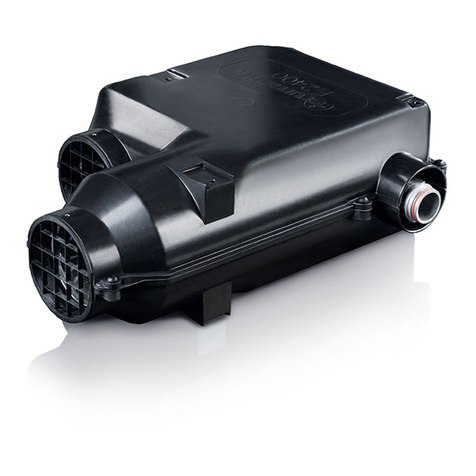
Truma
Truma Trumatic E 2400 E Operating and installation instructions

OYPLA Home
OYPLA Home 3680 user manual

Haverland
Haverland RCTT Instruction and installation manual

Trane
Trane GKNE ACCOMPANIMENT TO THE INSTALLATION, OPERATION AND MAINTENANCE MANUAL
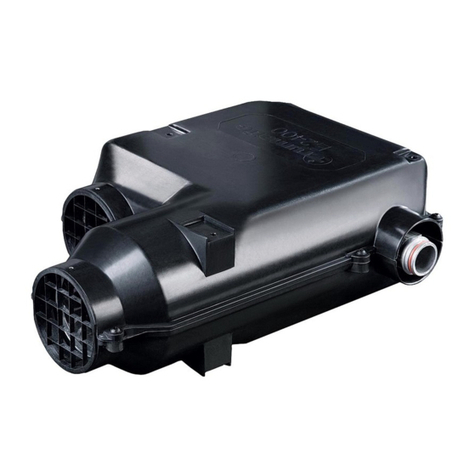
Truma
Truma Trumatic E 2400 E Operating and installation instructions
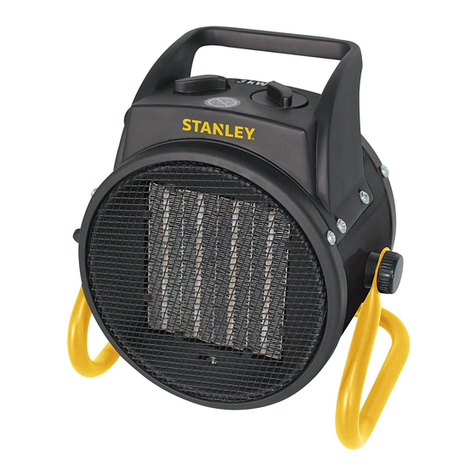
Stanley
Stanley ST-23-240-E instruction manual

